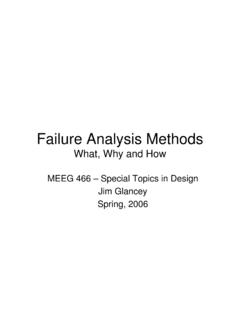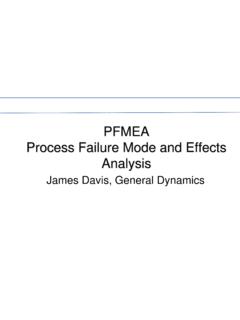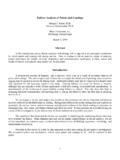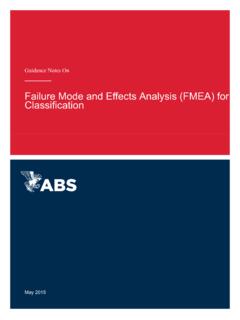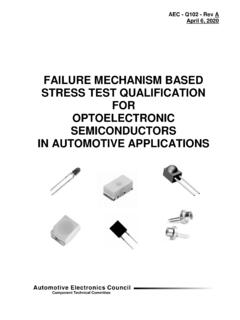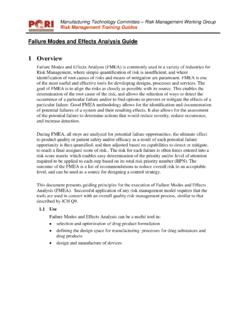Transcription of Failure Modes and Effects Analysis (FMEA) New 7 Step …
1 888-336-1124 | 20191 Failure Modes and Effects Analysis (FMEA)New 7 Step Approach!QSG Quarterly MeetingOctober 25, 2019 Laura | 20192 Agenda FMEA Alignment of AIAG & VDA 7 Step Approach Revised Rating Tables Key Changes Transition Strategy888-336-1124 | 20193 FMEA Alignment of AIAG & VDA888-336-1124 | 20194 FMEA Alignment of AIAG & VDA888-336-1124 | 20195 FMEA Alignment of AIAG & VDA Automotive suppliers to both North American and German OEMs were required to assess their Failure Modes and Effects differently Differences between the Severity, Occurrence, and Detection rating tables in the AIAG and VDA FMEA Manuals Caused confusion and added complexity to product development and process improvement activities Alignment was needed in order to create a common set of requirements so suppliers can have a single FMEA business process meeting needs and expectations of any of their automotive customers888-336-1124 | 201967 Step Approach888-336-1124 | 201977 Step Approach888-336-1124 | 20198 Source.
2 AIAG / VDA FMEA Handbook888-336-1124 | 20199 Step 1: Planning & PreparationFive T sQuestions to AnswerInTent Have all Core Team Members received training on FMEAs? Have all Core Team Members allocated time to fully participate?Timing What APQP Phase or VDA Maturity Level is the project in? What is the FMEA Start Date and Target Completion Date?Team Have the team members been assigned with clearly defined roles and responsibilities (Leader, Facilitator, Champion, Core Team Member, Extended Team Member)?Task Is the scope of the study clear? Has the documentation/reporting methodology been clarified? Will the FMEA Report be shared with customers? Will the FMEA results be audited?Tools Will a spreadsheet or specific software program be used to document the results?888-336-1124 | 201910 Step 2: Structure AnalysisDFMEA Identification of design interfaces, interactions, close clearance Tools: Structure tree Block diagram Boundary diagramPFMEA Identification of process steps and sub-steps Tools: Structure tree Process flow diagram888-336-1124 | 201911 Step 3: Function AnalysisDFMEA Association of requirements to functions Tools: Function Analysis tree Parameter diagramPFMEA Association of characteristics to functions Tools: Function Analysis tree Parameter diagramSource: AIAG / VDA FMEA Handbook888-336-1124 | 201912 Step 4: Failure AnalysisDFMEA Potential Failure Effects , Failure Modes , Failure Causes for each product function Tools: Parameter diagramPFMEA Potential Failure Effects , Failure Modes , Failure Causes for each process function Tools: Fishbone diagram (4M)Source: AIAG / VDA FMEA Handbook888-336-1124 | 201913 Step 5.
3 Risk AnalysisDFMEA Assignment of Prevention Controls to Risk Causes Risk Ratings (Dev, Occ, Det) Evaluation of Action PriorityPFMEA Assignment of Prevention Controls to Risk Causes Risk Ratings (Dev, Occ, Det) Evaluation of Action PrioritySource: AIAG / VDA FMEA Handbook888-336-1124 | 201914 Step 6: OptimizationDFMEA Assignment of responsibilities and due dates Implementation of actionsPFMEA Assignment of responsibilities and due dates Implementation of actionsSource: AIAG / VDA FMEA Handbook888-336-1124 | 201915 Step 7: Results Documentation Communicate results and conclusions of the Analysis Within organization With customers and/or suppliers (as appropriate) Document actions taken including effectiveness888-336-1124 | 201916 Revised Rating Tables888-336-1124 | 201917 DFMEA Severity TableSource: AIAG / VDA FMEA Handbook888-336-1124 | 201918 DFMEA Occurrence Table888-336-1124 | 201919888-336-1124 | 201920 DFMEA Detection TableSource: AIAG / VDA FMEA Handbook888-336-1124 | 201921 PFMEA Severity TableSource: AIAG / VDA FMEA Handbook888-336-1124 | 201922 Source: AIAG / VDA FMEA Handbook888-336-1124 | 201923 PFMEA Occurrence TableSource: AIAG / VDA FMEA Handbook888-336-1124 | 201924 PFMEA Detection TableSource: AIAG / VDA FMEA Handbook888-336-1124 | 201925 Source: AIAG / VDA FMEA Handbook888-336-1124 | 201926 Action Priority High (H): Requiredto identify appropriate action to improve Prevention and/or Detection Controls; OR justify and document why current controls are adequate Priority Medium (M): Shouldidentify appropriate actions to improve prevention and/or detection controls.
4 OR, at the discretion of management, justify and document why current controls are adequate Priority Low (L): Couldidentify actions to improve prevention or detection controls888-336-1124 | 201927 FMEA Action Priority TableSource: AIAG / VDA FMEA Handbook888-336-1124 | 201928 Source: AIAG / VDA FMEA Handbook888-336-1124 | 201929 Key Changes888-336-1124 | 201930 Item & FunctionDFMEA Structure AnalysisAIAG 4thEd FMEANew AIAG-VDA 1stEd FMEA888-336-1124 | 201931 Item & FunctionDFMEA Function AnalysisAIAG 4thEd FMEANew AIAG-VDA 1stEd FMEA888-336-1124 | 201932 DFMEA Failure AnalysisSeverityPotential Failure ModePotential Effect(s) of FailurePotential Cause(s)/ Mechanism(s) of FailureClassificationAIAG 4thEd FMEANew AIAG-VDA 1stEd FMEA888-336-1124 | 201933 Removed special characteristic identification not required in DFMEA; can use Filter Code column (optional)DFMEA Risk Analysis888-336-1124 | 201934 PFMEA Structure Analysis 888-336-1124 | 201935 PFMEA Function Analysis888-336-1124 | 201936 Potential Failure ModePotential Failure EffectsSEVC lassPotential Causes(s) of FailurePFMEA Failure AnalysisAIAG 4thEd FMEANew AIAG-VDA 1stEd FMEA888-336-1124 | 201937 PFMEA Risk Analysis888-336-1124 | 201938 DFMEA Optimization888-336-1124 | 201939 Transition Strategy888-336-1124 | 201940 Transition Strategy (Automotive Suppliers) Existing FMEAs developed per the AIAG 4thEdition can remain Plan the transition From current FMEA processes and methods to the new AIAG VDA FMEA process and tools Use existing FMEAs for a starting point Consider: Minor or major change, New rating scales, Analytical methods and format New projects Consider: Company leadership mandates, Customer Specific Requirements Transition date and milestones888-336-1124 | 201941 Questions?
5 ?
